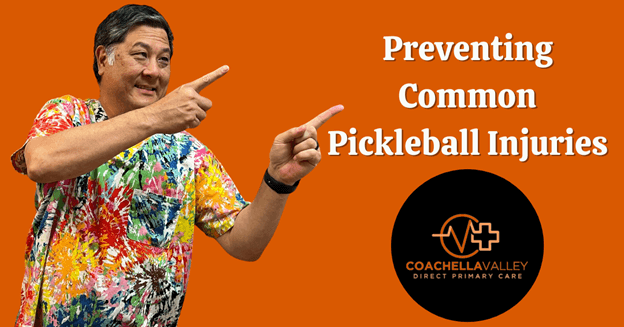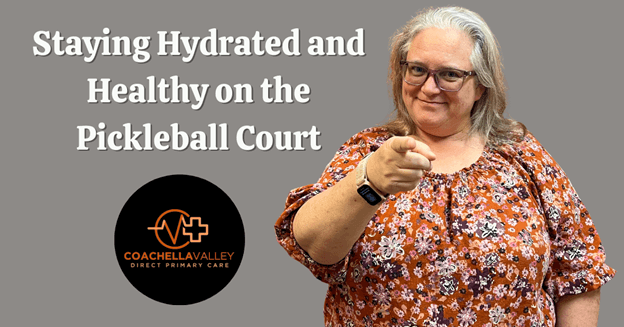Pickleball is taking the world by storm, and it’s no wonder why. Dive into this energetic game; it’s not only super fun but also gets you moving and shaking in great company. But as with any sport, there’s always a risk of injury. To make sure you stay swinging that paddle without any hiccups, I’ve got some advice on dodging injuries during your favorite pastime.
As someone who’s been playing pickleball for years, I’ve seen my fair share of injuries. From twisted ankles to strained muscles, it’s easy to get hurt if you’re not careful. But the good news is that most pickleball injuries are totally preventable. Diving into some basics and getting ready beforehand means staying injury-free during game time is totally doable.
Coachella Valley Direct Primary Care
Frustration-free health care for the whole family. A monthly membership program designed for the busy Coachella Valley family to give you direct access to primary healthcare services so you can be healthy and active. Schedule a free consultation. 760-642-5549
Table Of Contents:
- The Rise of Pickleball: Understanding Its Popularity
- Preventing Common Pickleball Injuries
- Addressing Overuse Injuries in Pickleball Players
- Acute Injuries on the Court
- The Role of Physical Therapy in Recovery
- Tailoring Your Play Style for Injury Prevention
- Staying Hydrated and Healthy on the Pickleball Court
- Navigating the Path Back to the Court After an Injury
- Conclusion
The Rise of Pickleball: Understanding Its Popularity
Pickleball’s popularity has skyrocketed in recent years, and it’s not hard to see why. This fun, fast-paced sport combines elements of tennis, badminton, and ping pong, making it accessible to players of all ages and skill levels. According to the Sports & Fitness Industry Association, pickleball participation grew by a whopping 21.3% between 2019 and 2020 alone. And it’s not just a passing fad – pickleball is here to stay. So, what’s behind this pickleball craze? Let’s take a closer look at the factors driving its popularity.
A Sport for All Ages
One of the biggest appeals of pickleball is that it truly is a sport for everyone. Whether you’re a young adult looking for a new hobby or an older player seeking a low-impact way to stay active, pickleball has something to offer. The smaller court size and slower ball speed compared to tennis make pickleball easier on the joints while still providing a great workout. This has made it especially popular among older adults and retirees. In fact, according to USA Pickleball, the average age of a pickleball player is 38 years old, with 75% of core players 55 and older. But don’t let that fool you – pickleball is gaining popularity across all age groups, from kids to college students to working professionals. The inclusive nature of the sport is a big part of its charm. It’s a great way to socialize, meet new people, and enjoy some friendly competition. Plus, with minimal equipment needed and easy-to-learn rules, it’s never been easier to get started with pickleball.
Preventing Common Pickleball Injuries

As much fun as pickleball is, it’s important to remember that, like any sport, it comes with a risk of injury. The good news is that most pickleball injuries are minor and can be prevented with proper preparation and technique. Some of the most common pickleball injuries include ankle sprains, hamstring strains, and shoulder pain from overuse. But don’t let that scare you off the court – there are plenty of simple steps you can take to stay safe and healthy while playing.
Importance of Warm-Up and Cool-Down Routines
One of the most important things you can do to prevent pickleball injuries is to properly warm up and cool down before and after playing. This helps get your muscles and joints ready for action and can reduce your risk of strains and sprains. A good warm-up routine should include some light cardio to get your heart rate up, followed by dynamic stretching of your legs, arms, and core. Focus on movements that mimic the actions you’ll be doing on the court, like lunges, arm circles, and gentle twists. After your game, take a few minutes to cool down with some static stretches, holding each stretch for 15-30 seconds. This can help improve your flexibility and reduce muscle soreness.
Choosing the Right Equipment
Another key factor in preventing pickleball injuries is using the right equipment. This starts with wearing appropriate footwear that provides good support and traction on the court. Look for tennis shoes or court shoes with a sturdy sole and plenty of cushioning to absorb impact. Avoid running shoes, which don’t offer enough lateral support for the quick side-to-side movements in pickleball. It’s also important to choose a pickleball paddle that’s the right size and weight for your skill level and playing style. A paddle that’s too heavy can put extra strain on your wrist and elbow, while one that’s too light may not provide enough power and control.
Addressing Overuse Injuries in Pickleball Players
While acute injuries like ankle sprains tend to get the most attention, overuse injuries are actually some of the most common issues faced by pickleball players. These injuries develop gradually over time from repetitive motions and strain on certain muscles and joints. Some common overuse injuries in pickleball include rotator cuff tendinitis in the shoulder, lateral epicondylitis or “tennis elbow” in the elbow, and patellar tendinitis or “jumper’s knee” in the knee. These injuries can cause pain, stiffness, and weakness that gets worse with activity.
When to Seek Medical Advice
If you’re experiencing persistent pain or discomfort that doesn’t improve with rest, ice, and over-the-counter pain relievers, it may be time to seek medical advice. A sports medicine doctor or physical therapist can help diagnose the issue and recommend a treatment plan. In many cases, overuse injuries can be managed conservatively with a combination of rest, activity modification, and physical therapy to address muscle imbalances and improve flexibility and strength. More severe cases may require additional interventions like bracing or injections. The key is to listen to your body and not push through pain. Catching and addressing overuse injuries early can help prevent them from becoming more serious and keep you on the court longer.
Acute Injuries on the Court
While overuse injuries may be more common, acute injuries can also happen in the heat of a pickleball game. These sudden injuries are often the result of a fall, twist, or awkward movement and can range from mild to severe. Some of the most common acute injuries in pickleball include ankle sprains, hamstring strains, and wrist fractures from falling on an outstretched hand. These injuries can be painful and may require a break from playing to allow for proper healing.
Immediate Response to Injury
If you do sustain an acute injury on the pickleball court, it’s important to take appropriate first aid steps right away. The RICE method – rest, ice, compression, and elevation – can help reduce pain and swelling in the affected area. Stop playing immediately and get off the court to avoid further injury. Apply ice to the injured area for 15-20 minutes at a time, several times a day, to help control inflammation. Use a compression wrap or sleeve to provide support and limit swelling, and elevate the injured limb above the level of your heart if possible. Over-the-counter pain medications like ibuprofen or acetaminophen can also help manage pain in the initial stages of an injury. But if pain is severe or you’re unable to bear weight on the affected limb, it’s best to seek medical attention right away.
The Role of Physical Therapy in Recovery
Whether you’re dealing with an acute injury or a chronic overuse issue, physical therapy can play a key role in your recovery and return to pickleball. A physical therapist can help assess your injury, identify contributing factors, and develop a personalized rehabilitation plan. In the early stages of recovery, your physical therapy sessions may focus on pain management, swelling control, and gentle range of motion exercises. As you progress, you’ll work on regaining strength, flexibility, and stability in the affected area. Your physical therapist may use a variety of techniques including manual therapy, therapeutic exercises, and modalities like ultrasound or electrical stimulation to help speed healing and improve function. They can also provide guidance on proper form and technique to help prevent future injuries.
Tailoring Your Play Style for Injury Prevention
In addition to proper warm-up, equipment, and medical care, there are also steps you can take on the court to reduce your risk of pickleball injuries. One of the most important is to pay attention to your play style and make modifications as needed. If you’re prone to ankle sprains, for example, you may need to focus on improving your footwork and balance. This could mean practicing lateral shuffles, single-leg hops, and other drills to strengthen the muscles around your ankles. For players with shoulder or elbow issues, it may be helpful to adjust your grip or use a lighter paddle to reduce strain on the joint. You may also need to limit overhead shots or high-impact serves until the injury has fully healed. The key is to listen to your body and not push through pain. If a certain movement or shot consistently causes discomfort, it’s best to avoid it until you can work with a coach or physical therapist to address any underlying issues.
Staying Hydrated and Healthy on the Pickleball Court

Finally, don’t underestimate the importance of overall health and wellness in preventing pickleball injuries. Staying hydrated, eating a balanced diet, and getting enough sleep can all help keep your body functioning at its best on the court. Proper hydration is especially crucial for pickleball players, as even mild dehydration can lead to fatigue, cramping, and decreased performance. Aim to drink 17-20 ounces of water 2-3 hours before playing and another eight ounces 20-30 minutes before starting. During your game, take breaks to drink fluids every 15-20 minutes, even if you don’t feel thirsty. Water is usually sufficient for games lasting less than an hour, but for longer play sessions or hot weather, a sports drink with electrolytes can help replace what you lose through sweat. Don’t forget about post-game hydration too. Weigh yourself before and after playing, and aim to drink 20-24 ounces of fluid for every pound lost to help your body recover.
Navigating the Path Back to the Court After an Injury
If you do find yourself sidelined with a pickleball injury, it’s important to give your body adequate time to heal before returning to play. Jumping back in too soon can put you at risk for re-injury or developing chronic pain. Work closely with your doctor or physical therapist to determine when it’s safe to return to the court. They may recommend a gradual progression, starting with light drills and building up to full games over several weeks. As you ease back into pickleball, be sure to listen to your body and watch for any signs of pain or discomfort. Don’t be afraid to take breaks or modify your play as needed to protect the injured area. It’s also a good idea to continue any stretching or strengthening exercises that were part of your rehabilitation program. These can help maintain the gains you made in physical therapy and reduce your risk of future injuries. With patience, persistence, and a focus on proper recovery, most pickleball players are able to successfully return to the sport they love after an injury. The key is to stay positive, set realistic goals, and celebrate each milestone along the way.
Key Takeaway:
Pickleball’s rise is fueled by its appeal to all ages and the joy it brings. But, playing safely means warming up, using the right gear, and not ignoring pain. Listen to your body, stay hydrated, and tweak your play style for injury prevention. Remember: a smart approach keeps you on the court.
Conclusion
To avoid getting sidelined by pickleball injuries, it’s all about taking steps early on. Kicking off with a solid warm-up, mastering your technique, and tuning into what your body’s telling you are key moves to dodge injuries.
Remember, it’s not about being the best player on the court. It’s about enjoying the game and staying healthy so you can keep playing for years to come.
So, next time you step onto the pickleball court, keep these tips in mind. Your body will thank you, and you’ll be able to keep smashing those volleys and dinking those shots like a pro.
Now get out there and have some fun – just don’t forget to stretch first!

